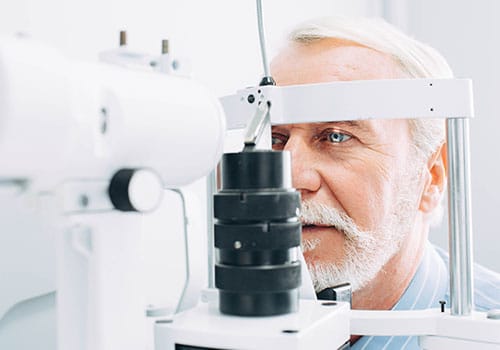Finding local providers in your area can sometimes be difficult, regardless of which type of insurance plan you have. However, the process can be even more difficult if you have Medicaid. You might find that many providers do not accept Medicaid benefits.
Eye care is critical to health care, so you should not skip routine eye exams. You need to follow the steps outlined in this article to find an eye doctor that accepts Medicaid so you can get the care you need. Different states have different rules regarding covered services, which we will touch on in this article as well. Keep reading to get all the details!
How To Find A List Of Doctors Near You That Accept Medicaid
Before you get a list of doctors in your area that accept Medicaid, you need to confirm your state’s Medicaid coverage of vision benefits. Since Medicaid is a program funded jointly by the federal government and each state government, the coverage details vary from state to state.
Review State Vision Coverage
Determine the type of service that you need from your eye doctor. If you need medically necessary treatment for an eye condition, like cataract surgery, these procedures are generally covered by Medicaid in all states.
Ophthalmologists perform these medically necessary services, and the eye care service provided either diagnoses or treats an injury or illness. Once you have been diagnosed with a specific condition, your treatments related to that condition should be covered by Medicaid. Some examples include glaucoma, dry eye disease, cataracts, macular degeneration, and retinal tears and detachments.
If you need to visit an optometrist for vision correction through a routine eye exam with eyeglasses or contact lenses, your state might not provide benefits for those services. At least 12 states do not cover all aspects of routine vision care. If you live in one of those 12 states, you will have no coverage for routine eye exams through the Medicaid program. The remaining 38 states offer some level of vision coverage for vision services through their Medicaid programs.
Determine Eligibility
Once you have determined the type of service you need and whether Medicaid will cover it, you should decide whether you are eligible. Even though your state might cover routine eye exams, you might only qualify for an exam once every two or three years. You should take a look at your records to determine when your last exam was performed. Use this information to decide on your current eligibility for the service that you require.
Find a Provider that Accepts Medicaid
Now that you know whether or not your service should be covered, you need to determine which provider takes Medicaid. You could attempt to call local providers in your area, but that would be time-consuming and tedious. There is a better way! Pull out your Medicaid ID card and examine it. You will find the name of the insurance company that manages your Medicaid plan there. You can use that information to visit the insurance company’s website and see a list of providers in your area.
Most plans allow you to search for a provider based on the type of service they provide, so you can limit your search to those providers who specialize in optometry or ophthalmology. Once you find a provider using your insurance company’s online directory, you should call them to schedule your appointment and confirm that they accept your Medicaid plan.
KEY TAKEAWAYS
- Medicaid is a program funded jointly by the federal and state governments, and each state is authorized to determine coverage details.
- Generally, all state Medicaid programs will cover services deemed medically necessary to treat an illness or injury, such as cataract surgery, glaucoma treatment, repair of a detached retina, or dry eye syndrome.
- Online directories established by the insurance administrator are typically the best way to find a provider that accepts Medicaid and performs the necessary services.
Verify Medicaid’s Vision Coverage First
Once you have found a doctor who accepts Medicaid, you will need to verify Medicaid’s coverage of the service that you need to receive. Remember that the specific coverage details of Medicaid vary from state to state. However, some general coverage details are similar across all states.
Standard Vision Coverage
First, Medicaid generally covers any medically necessary service to treat an illness or injury. This includes eye conditions like glaucoma, retinal detachments, cataracts, dry eye syndrome, and others. However, things get a little more confusing when it comes to routine eye exams and refractive vision correction.
State Specific Coverage
In some states, Medicaid does not cover routine eye exams for glasses or contacts for adults. Other states cover these exams, but you may only be eligible for an exam once every two to three years.
Coverage for Children
Medicaid is required to provide dental and vision coverage and regular health care services for children through the EPSDT program. So, children can get eye exams even in states that do not cover them for adults.
Contact Medicaid Administer
Finally, the best way to verify coverage is to contact the insurance company that administers your Medicaid plan. Look at your Medicaid ID card and find the company name and phone number. Call them, and they can advise whether a specific service is covered under your plan.
They can also inform you of any applicable copays or coinsurance amounts that might be due. Since Medicaid is designed to help low-income individuals and families, there are generally no copays due.
Medicaid vs Medicare Vision Coverage
Remember that there are also significant differences between Medicaid and Medicare. Medicaid is designed to help low-income people, while Medicare is intended to provide health insurance for seniors. Medicare does not cover routine eye exams in any state, and many people receiving Medicare choose to add separate vision coverage to their plan.
Must read articles related to Healthcare
- Steps to sign up for Medicare
- Does Medicaid cover braces?
- What is the difference between an HSA and an FSA?
- How might a Healthcare Proxy help you?
- Will Medicare or Medicaid pay for assisted living?
Services Available For Medicaid Patients
Each state sets its own rules regarding the eye care services available to Medicaid beneficiaries. Since Medicaid is a managed care system, these limits are in place to help manage the program’s costs. Generally, any medically necessary service is always available. An ophthalmologist typically performs these services. These services might include:
- Cataract surgery,
- Glaucoma treatment
- Repair of a detached retina or
- Treatment associated with dry eye syndrome.
Routine eye exams for vision correction with eyeglasses or contact lenses are not always covered. Some states do not cover these exams, while others cover them once every one to three years.
If you need to know whether a specific service is covered, contact your state Medicaid office or the insurance company that administers your plan. They can answer your questions and tell you whether a particular service will be covered.
Finding Eye Doctors That Accept Medicaid Via Online Directories
Online directories have pros and cons when it comes to finding eye doctors who accept Medicaid. One of the most significant benefits of using an online directory is making your search easy. Most directories allow you to input your ZIP code or address, and the directory will return a list of doctors near your location.
It also allows you to view all the details about each doctor in one place, such as their name, address, phone number, and website. These online directories also allow you to filter your search results.
For example, you can view only doctors who accept Medicaid, Medicare, or doctors with a particular specialty. Most people find that searching an online directory is one of the easiest ways to see a doctor who accepts Medicaid.
Drawbacks of Online Directories
Although there are many great benefits to using an online directory to find an eye doctor, there are also a few drawbacks.
First, some online directories are not kept up-to-date. This means that although the directory might list a doctor in your area, that doctor may have moved or no longer be in practice. In addition, they may no longer accept Medicaid. You can help avoid this issue by using the online directory provided by your insurance company instead of a generic online directory.
Lastly, some provider directories allow doctors to purchase premium spots in the directory. You might assume the doctor is highly rated, but that might not always be true. When using an online directory, make sure that you check other sources to verify a doctor’s ratings, and always call the office to confirm that they accept Medicaid.
TIP
After identifying an eye care center or doctor who accepts Medicaid, it is helpful to review their website, social media presence, and online reviews to determine if they are a good fit to perform the desired eye care service.
What Else To Look For In Eye Doctors That Accept Medicaid
Now that you have found a list of providers that accept your health plan, what else should you look for when choosing your eye doctor? You can look for several things when deciding who you will visit.
First, look at the online presence of the eye care center or doctor you consider visiting. Do they have an up-to-date website? If they don’t have a web presence, they might not have the latest technology in their office either.
Next, take a look at the provider’s presence on social media. You can often find the provider on social media and see photos of their office and staff and the latest news from their office. This is a great way to get a feel for how their office operates and whether their style fits your desires.
Finally, you should check out the provider’s online reviews. You can easily see what other people have to say about their experiences using Google reviews, Yelp reviews, and even social media posts. It would be best to avoid providers with low ratings. Finding a referral from a friend or family member can be a great way to find a doctor who would be a great fit.
The Bottom Line
Finding an eye doctor who accepts your insurance can sometimes be difficult if you have health insurance through Medicaid.
First, you should verify that Medicaid covers the service you need and that you are eligible to receive it.
Next, use your insurance company’s online directory to find a list of eye doctors in your area who accept Medicaid.
Finally, call your preferred doctor to make sure they still accept Medicaid before scheduling your appointment.
Frequently Asked Questions
Yes, telemedicine visits are covered by Medicaid as long as the service you receive is typically covered during an in-person visit. Medically necessary eye treatment is almost always covered by Medicaid, while routine eye exams are not covered in many states.
It is always wise to check with your insurance carrier before scheduling an appointment to ensure that Medicaid will cover the service.
Yes, Medicaid will typically pay for eye floater surgery. This surgery is usually considered a medically necessary treatment so that Medicaid will assist with the cost of the surgery.
Although Medicaid may not cover routine eye exams in many states, the program always covers medically necessary services and procedures.
Whether or not Medicaid pays for glasses depends on the state in which you live. Some states do not provide Medicaid coverage for eyeglasses at all.
Other states will cover a routine eye exam and one pair of eyeglasses yearly, while some states only provide this coverage once every two or three years. You can check with your state Medicaid office to determine coverage details for glasses in your area.
Yes, Medicaid covers cataract surgery, which is considered a medically necessary procedure. Cataract surgery, glaucoma treatments, retinal reattachments, dry eye syndrome treatments, and other services are also considered medically necessary for your eye health and overall health.
Medicaid will always pay for these types of services in all states. You must find a doctor who accepts Medicaid to perform the procedure. In addition to Medicaid, Medicare covers cataract surgery as well.
Contact lenses are usually only covered by Medicaid if they are medically necessary. Even if your Medicaid program provides vision benefits, the standard benefits will typically only cover eye exams and glasses.
Contact lenses are usually not included as part of your Medicaid benefits. However, in some cases, contact lenses might be the only option for treating certain conditions. In that case, your Medicaid will likely cover the contact lenses.
You can find a Social Security Administration office near you by using our SSA office locator and searching for your closest location.







